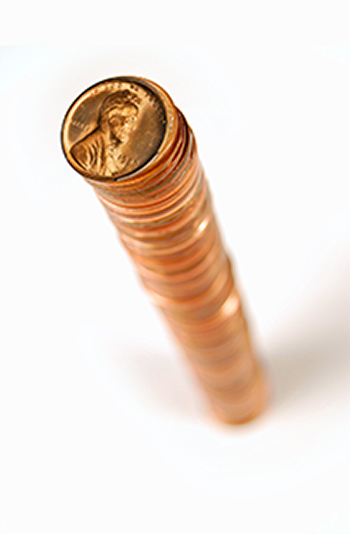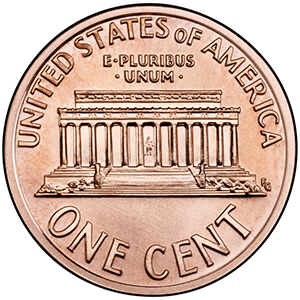
By Joshua McMorrow-Hernandez for CoinWeek …..
When the Lincoln wheat cents of 1958 were struck by the United States Mint, few individuals knew the coins would represent the end of a 50-year tradition. Collectors had little reason to suspect that the Lincoln cent, which had remained virtually unchanged since its debut in 1909, was set for a major overhaul in 1959. The general public had no knowledge that officials with the Mint and United States Treasury Department were quietly choosing a new one-cent coin reverse from a pool of 23 designs by four artists in an internal design contest.
* * *
For the first 50 years of its production, the Lincoln penny boasted a familiar design pairing: a distinctive profile bust of our nation’s 16th president Abraham Lincoln on the obverse, and two wheat stalks symbolizing national prosperity on the reverse. Both sides of the Lincoln wheat cent were the work of sculptor-engraver Victor David Brenner.
Enter the Memorial Cent
Changing the reverse of the Lincoln cent from the wheat ears design to the Lincoln Memorial motif was purposeful. The official release of the new Lincoln Memorial cent on February 12, 1959 coincided with the 150th anniversary of Lincoln’s birth.
The new Lincoln Memorial penny enjoyed a warm welcome from the American public, and the sub-series would continue in production until the bicentennial of Lincoln’s birth 50 years later in 2009, when the one-cent coin sported four commemorative reverse designs representing key periods in Lincoln’s colorful life. In 2010, the venerable Lincoln obverse was paired with a new permanent reverse by artist Lyndall Bass and U.S. Mint sculptor-engraver Joseph Menna that prominently features a union shield.
 The 2009 Lincoln Bicentennial commemoratives and the 2010 Lincoln Shield cent were widely publicized and publicly anticipated months before the new designs were released. But the emergence of the Lincoln Memorial design by Frank Gasparro in 1959 was a shock to all but a few outside of certain United States Mint circles.
The 2009 Lincoln Bicentennial commemoratives and the 2010 Lincoln Shield cent were widely publicized and publicly anticipated months before the new designs were released. But the emergence of the Lincoln Memorial design by Frank Gasparro in 1959 was a shock to all but a few outside of certain United States Mint circles.
“The change of the reverse from the wheat cent to the Memorial came as a complete surprise to the public,” says popular coin dealer and Lincoln cent expert Charmy Harker—aka The Penny Lady. The decision to redesign the Lincoln cent reverse was not made public, and design proposals were handled internally by Mint engravers and other government officials.
“The public learned of the new reverse through a press release that was put out by President [Dwight] Eisenhower’s office in late December 1958,” Harker relates.
Dropped like a numismatic bombshell was a release from Eisenhower Press Secretary James Hagerty on December 21, 1958. It reads:
President Eisenhower approved today the recommendation of the Secretary of the Treasury Robert B. Anderson for the minting of a new reverse side of the one-cent Lincoln coin as a feature of the Lincoln Sesquicentennial observance. Production of the changed coin will begin January second. In recommending the change on the Lincoln cent, the secretary of the Treasury and Department officials have been working with the Lincoln Sesquicentennial Commission, of which Senator John Sherman Cooper of Kentucky is chairman.
The press statement goes on to say:
The new permanent design was done by Frank Gasparro of the Philadelphia Mint and selected by Secretary Anderson and the Director of the Mint William H. Brett. Both Philadelphia and Denver Mints, which will begin production of the changed coin in early January, will have a supply for distribution on Lincoln’s birthday, February twelfth. More than 25 billion Lincoln cents of the present design have been minted since its adoption in 1909.[1]
The numismatic excitement surrounding the release of the first Lincoln Memorial cents in 1959 was likely not much unlike the fervor over the Lincoln Bicentennial cents in 2009. “There was a lot of buzz and hype surrounding the cent in 2009, and many eagerly awaited each of the new Bicentennial reverses throughout 2009,” says Harker. “However, because the redesign of the reverse in 1959 came as such a surprise to the public, I feel there was probably more excitement and anticipation when the 1959 Memorial cent was released.”
Perhaps adding to the elation over the new design was the body of opinion that the five-decade-old wheat ears design had grown long in the tooth. At least that’s what many members of the American Numismatic Association (ANA) thought in October 1955 when, according to Harker, the ANA passed a resolution during its annual convention in Omaha requesting the one-cent coin be redesigned, because “people were tiring of seeing the same old penny.”
An article by editor Elston G. Bradfield in the February 1959 issue of the ANA’s The Numismatist captures both the surprise and excitement the numismatic community experienced with the new Lincoln Memorial cent:
“Washington sources from time to time have denied there would be any change in the one-cent piece, although such a change was a ‘natural’ as part of the sesquicentennial of Lincoln’s birth. Evidently the latter was also the thought of the Lincoln Sesquicentennial Commission headed by Kentucky’s Senator John Sherman Cooper, Secretary of the Treasury Robert D. Anderson, and other Department officers, for they joined in recommending such a step to President Eisenhower. The President’s approval of the new reverse was made public December 20 last [year].”[2]
Bradfield further observed:
“Distribution of the new coin is eagerly awaited by numismatists, as it is the first change in regular coinage since the Franklin half dollar of 1948. Under federal law specifying that American coin designs cannot be changed oftener than every twenty-five years, only the quarter and silver dollar are now eligible for new designs. Neither is likely to be disturbed.”
Cent expert Harker says demand for the new pennies was fervid. “The public and collectors were very excited to have a newly designed cent, and the banks ended up having to impose limited of two to five coins per customer.”
 The new Lincoln cent appeared just as the hobby was enjoying unprecedented nationwide popularity, and certainly the new Memorial pennies stimulated what was then a quickly growing collector base. Mint set and proof set sales increased substantially from 1958 through 1960, with production figures for proof sets increasing from 875,652 to 1,691,602 during that three-year period and uncirculated set sales improving from 50,314 to 260,485 in that same timeframe[3]. The new Lincoln Memorial cent doubtlessly aided in the sale of both types of United States Mint collector sets.
The new Lincoln cent appeared just as the hobby was enjoying unprecedented nationwide popularity, and certainly the new Memorial pennies stimulated what was then a quickly growing collector base. Mint set and proof set sales increased substantially from 1958 through 1960, with production figures for proof sets increasing from 875,652 to 1,691,602 during that three-year period and uncirculated set sales improving from 50,314 to 260,485 in that same timeframe[3]. The new Lincoln Memorial cent doubtlessly aided in the sale of both types of United States Mint collector sets.
Balancing out the widespread enthusiasm for the new Lincoln cents were the critics who believed the new Lincoln Memorial design left plenty to be desired. Dissenters include numismatic author and historian Don Taxay, who derisively equated the Lincoln Memorial depiction to a “trolley car” and Cornelius Vermeule, the famous art scholar who referred to the new design as “mausoleum-like”.
With all of the buzz surrounding the new Lincoln Memorial cent in 1959, the last of the wheat cents were seemingly all but forgotten. Lincoln cents from 1958 are essentially no scarcer or more valuable than any other wheat cent from the ’50s. The Philadelphia Mint struck 252,525,000 in 1958, including 875,652 Proofs, and the Denver Mint churned out 800,953,300 business-strike examples. There are a few interesting 1958 Lincoln cent varieties and errors that pique collectors’ interest, such as the elusive 1958 doubled die and 1958-D repunched mintmark.
Yet Harker says the 1958 wheat cent, as a last-year type coin, does not seem to garner much individual attention from hobbyists.
“My experience is that I don’t have many collectors specifically asking for the 1958 cent as a particular special date to collect even though it is the last year of the wheat reverse,” she says. “I think most collectors just collect the 1958 [cent] as part of the series, just as they do the four new reverse designs in 2009.”
Harker says her customers seem to prefer first-year type coins, especially those that contain major die varieties and errors. But even in that regard, the first-year type 1959 Lincoln Memorial cent receives little notice from collectors and is hardly deemed a “special” coin by many.
“In my experience, the varieties in 1959 are not as sought after, at least not as far as my Lincoln cent customers are concerned, because there are really no major or bold varieties,” Harker remarks.
1959-D Wheat Cent Reverse
The most notable of 1959 Lincoln cents, the 1959-D Lincoln penny with wheat reverse, may or may not even be real. “The story of the possible transitional 1959-D wheat reverse is intriguing,” Harker comments. News of the purported mule error first surfaced in 1987 when Leon Baller, a retired police officer, said he bought a 1959-D Lincoln wheat cent for $1,500 USD. The coin was submitted to the United States Department of Treasury, and currency agent Richard M. McDrew replied with a letter stating the coin was microscopically inspected by a Forensic Services Divisions expert and was determined to be authentic[4].
The coin has been submitted to third-party coin certification services over the years since, and none of the companies have graded the coin or confirmed its authenticity. Despite the fact that most numismatic experts believe the coin is fake, it has been sold “as-is” and without guarantee at auction for as much as $48,300. Only one specimen is known.
“The designer of the Lincoln Memorial reverse, Frank Gasparro, [denied] the possibility that such a mule exists and stated that such no test specimens were made,” Harker remarks.
Whether or not the 1959-D Lincoln wheat cent is authentic or merely an altered fantasy coin, 1958 was the last year that regular-issue Lincoln wheat cents were struck, and they remain plentiful and largely inexpensive (they’re even still occasionally found in circulation). While many collectors wouldn’t give 1958 Lincoln cents a second thought as a standalone collectible, these now-obsolete pennies are nevertheless numismatically significant coins that represent the end of an era.
* * *
Notes
[1] As presented in A Guide Book of Lincoln Cents (Whitman Publishing, 2008), by Q. David Bowers.
[2] Bradfield, Elston G. “The New Lincoln Cent.” The Numismatist Feb. 1959: 130, 150. Print.
[3] Figures from mintsetguide.com and lynncoins.com.
[4] http://www.pcgs.com/news/the-mystery-of-the-1959-d-mule-lincoln-cent





My somewhat naïve take on the purported 1959-D wheat cent is that it’s unlikely, but not impossible, to have been the result of a mismatched die pairing. Mismatched dies would have resulted in striking many such coins until either the error was discovered or the die was swapped out due to normal wear. The only way this scenario to have resulted in a single extant coin would be if QC had tried to track down all such mules but missed a single coin, either accidentally or deliberately.
That leaves the option that this coin – if genuine – is the result of intentional shenanigans by Mint employees, somewhat akin to one of the hypotheses regarding creation of the five 1913 Liberty nickels.